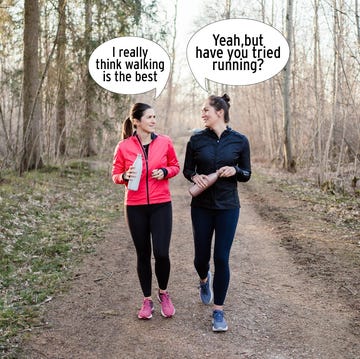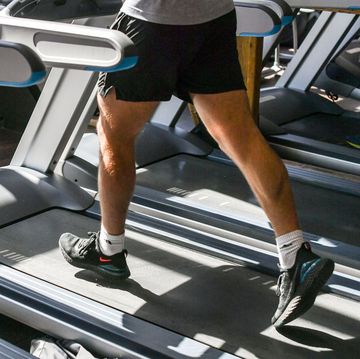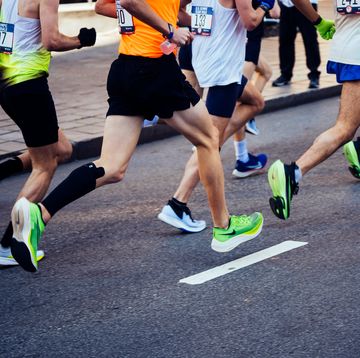Running cadence – defined as the amount of times that your feet hit the ground in a given minute – is one of the most discussed aspects of running technique. That’s partly because there’s good evidence to suggest that, for some runners, a quicker cadence may result in greater running efficiency and fewer injuries. But it’s also because the proposed solution is simple: just hone a cadence of around 180 steps per minute (spm) and you too will run with the elegance of an elite. Right? Well, not exactly.
To find the genesis of the 180 spm suggestion, we must go back to a study of elite runners at the 1984 Olympic Games in Los Angeles. Performed by legendary running coach Jack Daniels, the man who came up with the ‘10% Rule’ for building mileage, it found that Olympic distance runners tended to have a cadence of 180 steps per minute (or three foot strikes per second), or higher. From this relatively specific study, on elite runners running very quickly, 180 spm has been touted as the gold standard cadence for all runners across all distances.
Unsurprisingly, it’s not as simple as that. A 2019 study, published in the Journal of Applied Physiology, suggested that a wider range of cadences could be considered optimal. The study looked at the top 25 male and female finishers at a 100K ultramarathon and it found numbers ranging from 155 to 203. ‘One of the most striking findings was that the highest and lowest averages finished within a couple minutes of each other,’ said study author Geoffrey Burns. Interestingly, however, when researchers took the average of all the runners’ cadences, the number was 182 – just a tad higher than the oft-lauded number of 180.
What everyone's reading
So what other variables might be contributing to a runner’s cadence? Speed is perhaps the most obvious – the faster you go, the higher your cadence is likely to be. But what about height? Runner’s World caught up with running physio Tom Goom to get his expert view.
How height affects running cadence
‘Taller runners tend to have a lower cadence,’ says Goom. ‘This is thought to be because they have longer legs, which results in greater stride lengths. This means that they can cover a larger distance with each stride and so require a lower number of steps per minute to achieve the same speed as a shorter runner.’
Research in ultramarathon runners bore this out. The data suggested that for each additional 5cm of height, cadence is expected to decrease by approximately 6 spm. ‘However, there is likely to be individual variation, as many factors can influence cadence and this particular study is on elite athletes,’ adds Goom.
What other variables can naturally affect cadence?
Cadence can be affected by running speed, incline and surface. For example, it tends to be higher on a treadmill than over ground.
‘As we run faster, cadence tends to increase,’ says Goom. ‘These changes are modest at endurance speeds but increase more significantly as we transition to sprinting.’
Running uphill usually results in a higher cadence, too, while running downhill often causes a lower one – although this can vary with technique. ‘A runner looking to pick up speed while descending a hill may opt for a low cadence with large strides to take advantage of the slope,’ says Goom. ‘Conversely, a runner aiming for a slower, controlled descent may opt for a short, quick footfall. Age and running experience can also influence cadence, with novice runners tending to have lower step rates that then can increase over time as a runner ‘self-optimises’ their running gait.’
What’s the best way for runners to increase their running cadence sensibly?
Seek advice from a qualified professional before making changes to your running gait, as these changes should be based on your individual needs and goals.
‘It’s best to base any increase on your habitual step rate, usually at your preferred training speed and increase by approximately 5-10%,’ says Goom.
A large study found that the preferred speed on a treadmill tends to average at around 10km/hour and that the average spm is 164 (which is some way below the 180 that’s often recommended).
So, for example, if your spm is 160, you may start by increasing this by 5%, which would be 8 spm, resulting in a target cadence of 168. ‘To achieve this while running, you can use a metronome app set to 168 spm and run to the beat of the metronome,’ says Goom. ‘Alternatively, running to the beat of music can also be effective if its beat matches your target.’
Sustaining an elevated cadence can be hard, so it’s usually best to start with a small change and maintain it for 20-30 second bursts intermittently during runs (rather than trying an entire 10K run at a new step rate).
‘This should feel manageable in terms of effort and shouldn’t result in any new pains while running,’ says Goom. ‘If it isn’t comfortable, return to your usual running style or consider a smaller change.’













